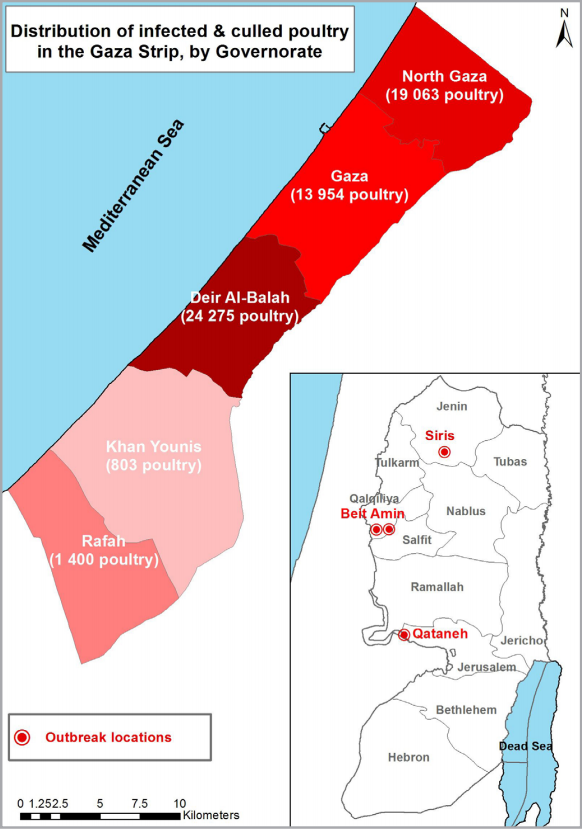Avian influenza in the Gaza Strip
Bird flu thought to be contained, but new outbreaks have occurred in recent months
Since March 2015, the highly pathogenic avian influenza (HPAI) of the H5N1 subtype has caused 37 poultry outbreaks in the Gaza Strip and required culling operations on 52 premises, resulting in the destruction of 66,243 poultry under standard disease control measures. H5N1 HPAI, also known as ‘bird flu’, affects poultry and is often lethal, endangering farmer livelihoods and presenting significant risks to the poultry sector, as well as the country as a whole, through negative implications for food safety and trade economies. In rare instances, H5N1 has caused human infections, sometimes leading to serious illness and even death; although no human infections have yet been identified in Gaza.
Since 2003 when H5N1 was first detected in humans in Southeast Asia, international agencies and governments have implemented rigorous measures to control the disease and prevent it from spreading. The United Nations established the UN System Influenza Coordination (UNSIC) office to assess member states’ efforts to control the disease at its source.The Food and Agricultural Organization of the UN (FAO) has taken a lead coordination role globally, providing control and preparedness support in the form of services and supplies to 95 countries, as well as working in cooperation with key stakeholders like the World Health Organization (WHO) and the World Organisation for Animal Health (OIE).
More than 8,400 outbreaks have been reported to OIE globally since the end of 2003. On a regional level, several countries in the Near East and North Africa, including the West Bank and Gaza Strip, have experienced outbreaks, with Egypt facing the most persistent and serious threat since the virus has become endemic in poultry populations there.

H5N1; a threat to Palestinian farmers?
In January 2015, the West Bank reported its first outbreak (since March 2011), on a Turkey farm in the northern village of Siris that led to the death of 17,400 birds, followed by three other outbreaks on layer farms between January and March. FAO supported the Ministry of Agriculture (MoA) to respond, including by facilitating a joint technical assessment mission from the Crisis Management Centre-Animal Health (CMC-AH) to the West Bank. No new outbreaks have been reported in the West Bank since March 2015. Improving the capacity of the MoA’s veterinary services to address similar crises is essential to build resilience and minimize future risks, especially given the HPAI situation currently emerging in the Gaza Strip.
The first case of avian influenza in the Gaza Strip since 2006 occurred in March 2015, with around 1,200 infected chickens on a farm in the Alkasseb neighbourhood of Jabalia. April then saw another 929 chickens destroyed by veterinary services as part of disease control measures in Khan Yunis and the north.
For much of May, most stakeholders working on animal and public health issues operated under the assumption that the round of outbreaks had been contained. However, May, June and July witnessed 36 additional outbreaks throughout all districts of the Gaza Strip as of 3 August. The virus was detected in almost all poultry types, but predominantly in layer chickens and ducks. The rapid increase in the number of outbreaks means that Gaza faces an elevated risk of H5N1 HPAI becoming endemic in the local poultry population. In addition to the actual and potential damages to the poultry sector and broader economy, given that the poverty rate and malnutrition are high in the Gaza Strip, poultry and eggs provide a relatively cheap and important protein source that needs to be protected. The zoonotic nature of the virus, occasionally causing infections and death in humans, is a further threat that requires appropriate awareness raising and the use of preventive measures.
This reality led the MoA to request that FAO send a second technical mission to assess the emerging situation in the Gaza Strip and prepare recommendations for improving the response, as well as determining what resources will be needed to ensure that this series of outbreaks is contained as soon as possible. The mission – which includes an epidemiologist, risk assessment and a risk management expert, risk communication expert and a laboratory expert – took place during the second week of August and included conducting an epidemiological assessment; assessing gaps and needs for capacity building; understanding the risk perceptions of local stakeholders; determining the support required to strengthen preparedness and response capacity; facilitating regional cooperation resources; and identifying resources. The findings and draft recommendations of the mission were presented to the MoA and general public on 13 August.
* This item was provided by FAO









